-
Posts
2,616 -
Joined
-
Last visited
Content Type
Profiles
Forums
Store
Help Articles
Posts posted by Peter the eater
-
-
This was a typical church fundraiser dinner - they served two hundred people between 4 and 7pm. Most people went for the $20 lobster which was served boiled and cooled with two scoops of potato salad on lettuce, coleslaw, cucumber and lemon slices, melted butter, fresh buns, a desert, a glass of wine and a cup of steeped hot tea:
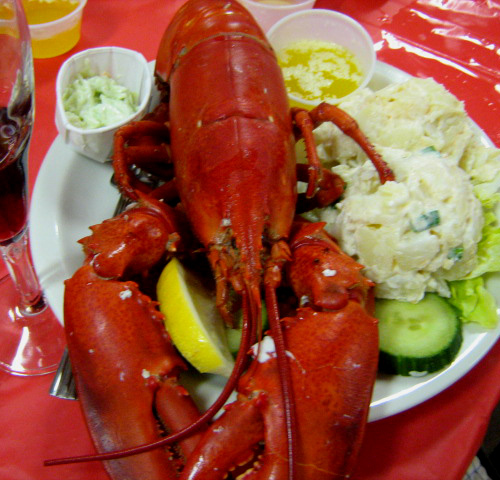
The fisherman who caught the lobsters was there - he brought over a gross of market lobsters (144 @ 1.5lbs) right off his boat. His traps are all within 5 km of the church making it very appealing to my inner locavore.
-
There was a traditional lobster dinner at the Catholic church not 200 meters down the road today. You could opt for a market lobster (around a pound and a half) or a ham diner. . .

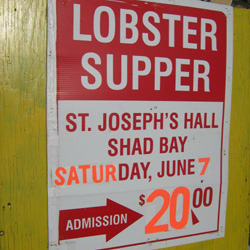
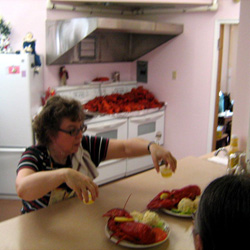
A list of desserts . . .
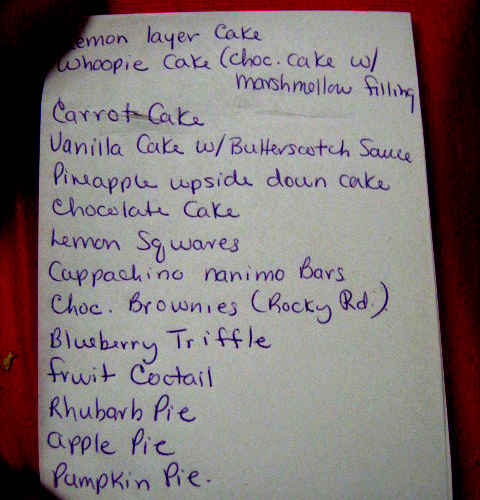
A silent aucion:

And a daughter-dad lobster moment:
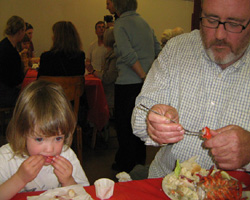
-
Another transplated Nova Scotian here, but my family left when I was very young. One of the things I looked forward to most, when we would go back to visit family, is oatmeal pudding (looking it up on-line, it's also known as mealie pudding or white pudding). It's a sausage skin stuffed with oatmeal, suet, onions and seasonings. We'd cut it into disks & fry it or slit the skin & bake it. Yum. I always preferred it fried - it would get so nice and crunchy.
I guess it's not exactly "Nova Scotian", but it's the first food I think of when I think of my times there.
One of my friends had to go to Nova Scotia on business, so I had him looking for it, and he did bring me back one, although he was quite disgusted by it and wouldn't try any.
I'll take the mealie pudding over blood pudding nine times out of ten. Oatmeal pudding is not hard to find in Nova Scotia but I'd say the black and white puddings are even more common in Newfoundland - the kind of thing you might find in someone's freezer or at a gas station. "Pudding" and "sausage" are words that can be used interchangeably in this context. The famous haggis sausage is of course the "great cheftain o' the puddin' race" according to Robbie Burns. Etymologist Bill Casselman has a good explanation here.
-
So far so good, no surprise. Looking forward to the pix . . .
-
Some of the things I look forward to enjoying for the first time:
1. Fresh foie gras from Quebec
2. Fugu
3. Seal flipper pie
4. Golden Ossetra caviar
-
Birding is a bit like cooking. You hear about these things, often rare or notorious, you do some research, maybe travel somewhere to achieve your goal and when you do, it’s soooo gratifying you take a picture.
People who love to watch birds often have a list of species that they can check off as they go. You can place as many birds on the list as you like - after 9,000 you start running out of species not to mention the time and resources.
It might be interesting to hear what dishes or ingredients constitute the unrealized fantasies of Society members . . .
-
Re-reading this thread is like pulling out a old favorite cook book. I knew I saw that beautiful grouper somewhere, it was back on post #199 all along!
The blue highlights are startling. Once in a blue moon (sorry!) a lobsterman here in maine catches a pure blue lobster in their traps. Apparently the odds are one in 2million of getting a blue one. They build an aquarium for it when they find one. Here is a picture of one.I think that there are two main pigment groups in lobsters, reddish and blues. The blue is heat sensative, hence they 'turn' red with cooking. I would guess that blue lobsters lack normal amounts of red pigment. They are most likely quite pale when cooked?
These comments were made almost 3 years ago, but . . .
That's the pigment story I know - just like maple leaves loose the green chlorophyll in autumn to reveal the reds and yellows.
There are a few blue lobsters at my local pound. They are "pets" and not for sale, I'll take a picture next time (I go every Wednesday
 ). The boys say that blue lobsters are much more common now than they used to be but nobody knows why.
). The boys say that blue lobsters are much more common now than they used to be but nobody knows why. -
My mother cooked this beautiful fish tonight, it's a type of grouper but i have no idea what kind. Any ideas?
Pre and post steaming with salted pork and shitake musrooms, deeelish!
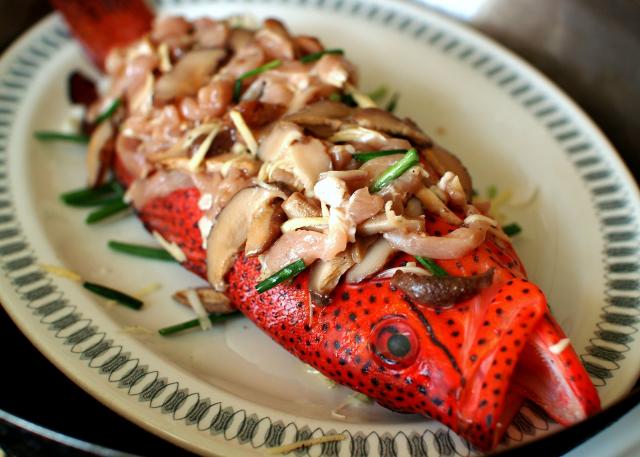
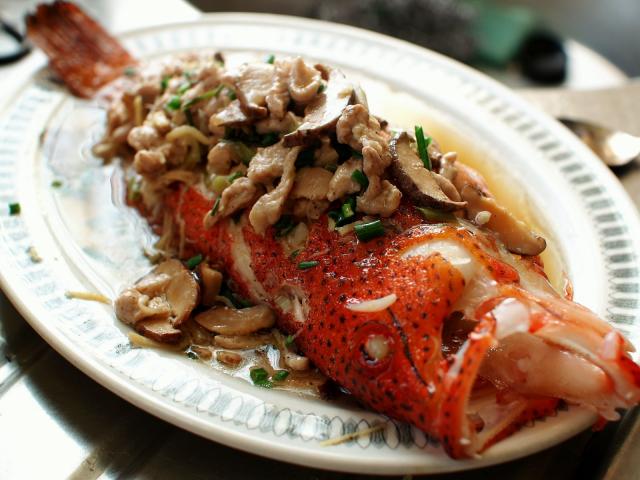
That looks like something from a tank at the pet store!
Red grouper is available Florida but I'm not sure that's what you have. I found this picture (click) of a guy spearfishing in the Red Sea, but the species is not identified.
-
Great story Rob, and good on you to help preserve the past. Its amazing how a few fragments of someone else's life can stimulate the imagination.
A few years ago a friend of mine found some ceramic pieces while scuba diving. One of the fragments had a partial swastika on it!
These shards are believed to have come from a German U boat during WWII - apparently most of the harbors on the eastern seaboard were visited. Creepy.
-
I'm just catching up on this adventure of yours - distracted by hockey on tv right now (boo Detroit). You are always so good at finding the deals - today I found a place to get high quality Lebanese EVOO for $5 per litre! Almost as much as gasoline.
I'm no expert on pulled pork, but I make it a few times a year and it's always good. It's not the cut, it's how you treat the pork, as you know. A loin will be beautiful - just get it all melted down with gooey flavor and then pull it apart with forks.
Do what you always do and it'll go well. Anyone from California can handle an 85F kitchen!
-
This is a very good banana tutorial, thanks. They truly are one of nature's most perfect foods, even the GMO ones!
The cavendish is one of those ubiquitous items that's in every store in every town - like a navel orange from Florida - and it's staggering to think of the numbers.
One of the gas stations in town for some reason had a pallet of bananas that reached the ceiling. They were getting real ripe real fast and the price was $0.09/lb. As in nine cents a pound. I grabbed a bunch mostly out of courtesy and I got change from a quarter.
Other than that one magical banana moment, they have been holding firm at $0.75/lb. For the same price you can sometimes get little red ones - they are firm, creamy and full of banananess. Also available at my supermarket are plantains and organic bananas which I'm pretty sure are also cavendish.
So to answer your question, it does sound like a dire situation if science can't fix the problem. Selfishly, I'd love to have access to a whole spectrum of banana types, including the leaves, but realistically that may not happen and like many I'm only willing to pay so much. It's hard to imagine paying top dollar for something we now take for granted, something to which we may already feel banal - or should that be bananal?

<edited to replace palette with pallet>
-
A few months ago I saw a CIA online video showing what looked like a good method for doing SP fries but I can't seem to find it again. I'm sure its still out there somewhere - it involved a batter or coating of some kind, and the chef was Swedish.
-
Lunenburg sausage is definitely a traditional food of Nova Scotia.
No matter where you are in North America you probably don't have to travel very far to find a local version of the pork sausage. I recall a good episode of Alton Brown's Good Eats from a few years ago in which he declares the sausage to be the food that best represents America because it is so widely made and enjoyed.
There are a few variations on the "famous" Lunenburg sausage but the two I know best are the fresh sausage and the pudding. The former comes in a big coil or as links and has a considerable bite to it. There are a few outfits down the south shore that make the sausage but I can't seem to get an actual recipe from anybody. This sausage is often used to anchor a stew featuring lots of winter root veggies.
Personally I prefer the pudding - it comes in a 2" diameter collagen casing and can been eaten as is. It's a much darker color than the fresh pink sausage and it has a very herbaceous taste with a major hit of onion up front. Here's how it looks fresh and fried, followed by an example of how it's used (I like that the recipe calls for the imperial 4 - 6" or metric 10 - 15 cm):



-
My mother-in-law has a large collection of Maritime local cookbooks, however, and one of them was from Lunenburg...I can't recall the name now - but have you seen it?
I did some looking around in my cookbook stash - all I could find is this one:
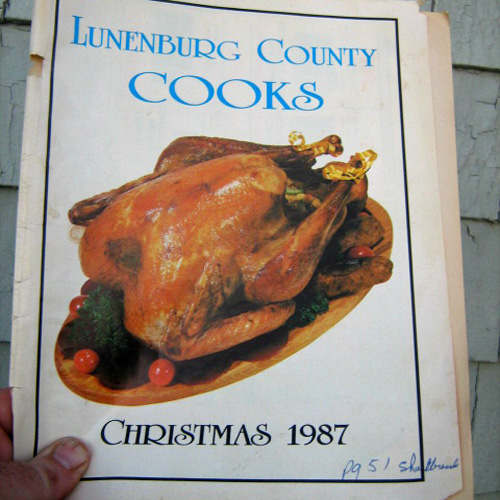
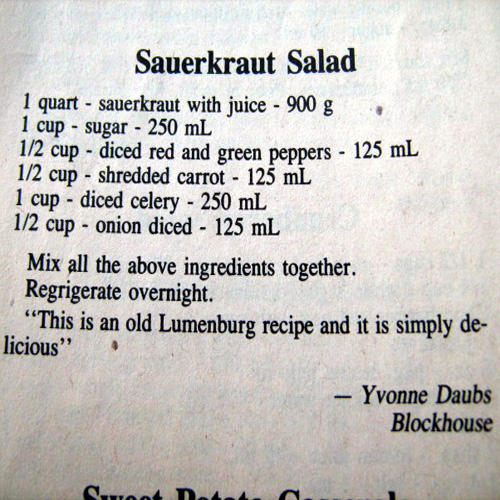
which tells me how to make a proper Lunenburg sauerkraut salad and that I should wash my hands and paint the house.
-
. . . . And tell us what your favorite way of giving is.
There are a lot of good food charities out there, freerice.com is one I love and hate. Just when you get a few definitions ahead . . . . $#%$!
I'll be giving to a food charity next month: Farmers Helping Farmers. Here's how they describe themselves:
Farmers Helping Farmers is a nationally recognized, award-winning organization of community-minded people with an agricultural background from Prince Edward Island, Canada. Our goal is to assist Kenyan farmers in becoming more self-reliant in agricultural food production. Together, we develop small-scale, practical agricultural projects, focusing on direct, person-to-person interaction, with little or no government structure.I wasn't aware of this cause until a friend told me that she's going to raise funds by swimming across the Northumberland Strait and back in around 15 hours. Like freerice, this one is connected to the UN in that she'll also be raising money for the Stephen Lewis Foundation which exists "to ease the pain of HIV/AIDS in Africa at the grassroots level".
My friend's site is http://www.kristinroe.com/.
-
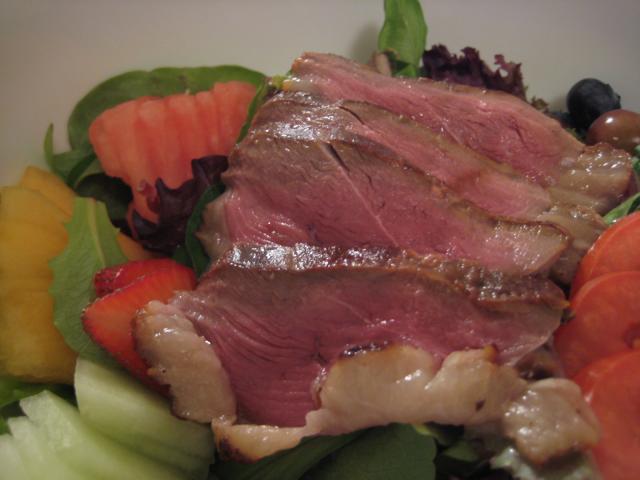
Ooooo . . . that is a thing of beauty and totally within my zone of desire.
I've had very good results from fresh and frozen duck breasts - may I ask which was that one?
-
. . . . In fact, that's what we were really fighting over - he maintained that a larger berry was juicier, and I thought a smaller, wild berry had much better flavour.
I think that wild versions of food are often more compact and lean, like a scrappy little fighter that has to work hard to survive.
Take ducks for example, the ones you shoot from a boat on the lake are dark and sinewy with just enough adipose tissue to keep them warm and afloat - very lean and very flavorful. Get a farm-raised duck and you need spend considerable time just rendering and controlling the copious fat that comes streaming out of the tissue. Also tasty, but quite different.
I do think the smaller wild berries have a more intense flavor. It seems there are also high lowbush berries and low highbush berries, just to complicate things further.
So when it comes to something like a grunt where the berries are stewed on the stove with water and sugar and maybe a few spices (and orange juice in Newfoundland & Labrador) you could achieve the desired thickness and flavor intensity using any type of blueberry. At least that's my theory.
-
I'm sure Oregon and Ontario blueberries are just fine.
It's funny how communities can get so territorial an competitive when it comes to things like that. The wine industry is probably the worst of all.
The more important difference for me is the that of high bush versus low bush blueberries. The wild low bush berries are much smaller and have a concentrated flavor - just like strawberries. They're harder to pick and you have to wait until August, making them even more desirable in that "playing hard to get" kinda way. We can usually harvest a few flats at the farm in late summer - I'll make a tradition grunt for this thread at that time.
I also like using blueberries as a condiment for seafood - particularly salmon. I think this is also popular on the west coast. That deep blue and orange/pink look so appetizing beside each other on a plate.
-
I'm a transplanted Nova Scotian, but neither of my parents were originally from Nova Scotia, so I grew up eating the dishes of my father's childhood (in Hong Kong and Singapore) and my mother - well, she was from the North, so she cooked a lot of game and things from scratch that most people bought - beans, bread.... but I don't remember eating "Nova Scotian", except in August, having to deal with all the blueberries. . . .
Are you suggesting it's possible to have too many blueberries? They are an anti-oxidant superfood and they taste really good. Oxford claims to be the blueberry capital on Nova Scotia - the berry company based there is one of the county's major employers.
. . . . I also seem to remember that it's claimed that pasta primavera was invented in Nova Scotia. Don't know who's claiming that, though, it seems a bit farfetched.And what of potage?
I've not heard that of pasta primavera - sounds unlikely but worth investigating.
I've seen various potages in Acadian cookbooks and on some menus. I think any thick soup can qualify as a potage - potato, pea, onion and pumpkin are common ingredients. Anglo gardeners often refer to their herb garden as a potage garden - I assume because of all the plants that could wind up in a soup.
-
Dulse and beer?
My parents immigrated to Nova Scotia from western Canada after I left home so I didn't gain much knowledge of local cooking - aside from getting jugs of seawater for boiling lobster.
The other thing I remember is the availability of wonderful old varieties of apples.
Mmmmm . . . seaweed and beer.

Using seawater to boil lobsters is convenient and effective but I don't find it really makes much difference. My preferred way is to steam a 1 1/2 pound lobster for fifteen minutes with an inch of fresh water.
You're right, there are lots of good apples in the Annapolis Valley. I'm originally from Upper Canada and I've spent a lot of time along the Apple Route in eastern Ontario (highway #2) so I think I've been a bit desensitized.
. . . . You didn't mention the immigrant freed slaves who found refuge in Nova Scotia (as opposed to the Acadians who went the other way). Are there any remnants of their cooking culture?Actually, I did:
. . . . After the US War of Independence, white and black Loyalists arrived bringing their own food traditions."Black Loyalists" refers to the thousands of African North Americans that migrated to Nova Scotia during and after the American Revolutionary War. Some were free but most actually remained slaves until it was abolished throughout the British Empire in the 1830's - three decades before Canada was born. As far as their cooking culture goes, I don't know enough to do that question the justice it deserves - not yet.
-
Is there anything that resembles a lobster roll in your neck of the woods?
There certainly is, and they're not hard to find - especially in summer. Best one I've had was in Ingonish, Cape Breton near the foot of the ski hill. They do lobster and crab rolls, both are excellent. I don't know the name of the place but it should be the only lobster shack around.
We typically make lobster rolls for lunch the day after a big boil. The leftover tails and claws (if there are any) are added to the meat from all the missed legs and various overlooked joints.
As far as I'm concerned, there are two keys to a proper lobster roll. First, you need ultra fresh white buns and second, you need a meat-rich mixture to go into the roll. A little onion, celery, garlic, lettuce or chive embellishment is permitted as long as there is clearly a majority of lobster meat and just enough mayo to make it all come together.
-
When I visited Lunenberg one weekend - I seem to remember that pickled fish was a big item there.
Like this?
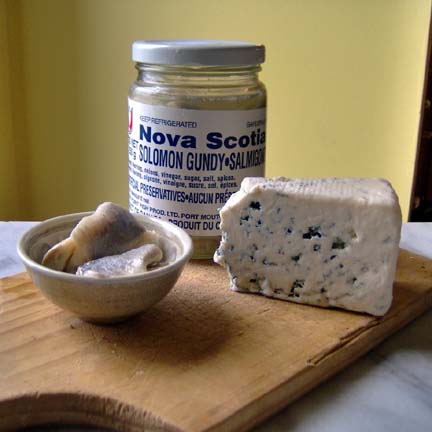
This is a jar of pickled herring and it's very popular in the German communities of Lunenburg county where I think this one is made. It's really, really hard not to eat the whole jar in one sitting.
I thought I had the story straight about solomon gundy but now I'm not so sure. I recently read something about Jews bringing it to the Caribbean as they were trying to avoid the Spanish Inquisition. Whatever the forces at work were, I'm just grateful to have been united with the jar above.
It came up in my eG Foodblog last May:
QUOTE(MarketStEl @ May 24 2007, 12:31 AM)Pickled herring, right?
How'd it get the name "Solomon Gundy"?
Isn't that a Mother Goose rhyme? ("Solomon Gundy, born on a Monday...")
*
Yes it is pickled herring, with some onion and spices. The story I know is that the name comes from salamagundi which is an old English style of salad with all kinds of stuff in it, including fish.
Solomon-a-Gundy is mackerel and shad boiled together, from Jamaica.
Solomon Grundy with an r is a Victorian English nursery rhyme:
Solomon Grundy,
Born on a Monday,
Christened on Tuesday,
Married on Wednesday,
Took ill on Thursday,
Grew worse on Friday,
Died on Saturday,
Buried on Sunday.
That was the end of
Solomon Grundy.
Solomon Grundy is also a bad guy zombie in the comic books.
-
No matter where you are in Nova Scotia, it's impossible to get more than forty miles away from the ocean - so it's no surprise that seafood has played a significant role in the traditional diet.
That's why I'm kicking off this topic with smoked eel or kat in the language of the Mi'kmaq:

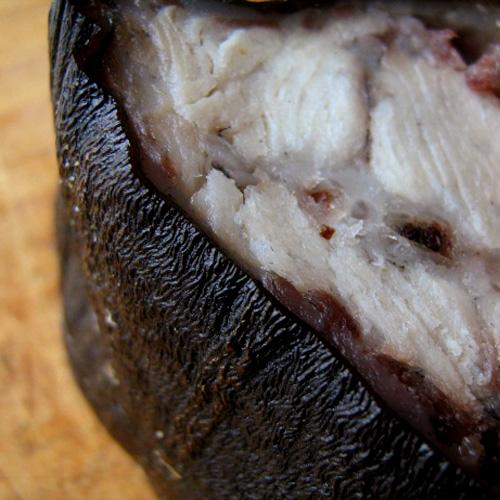
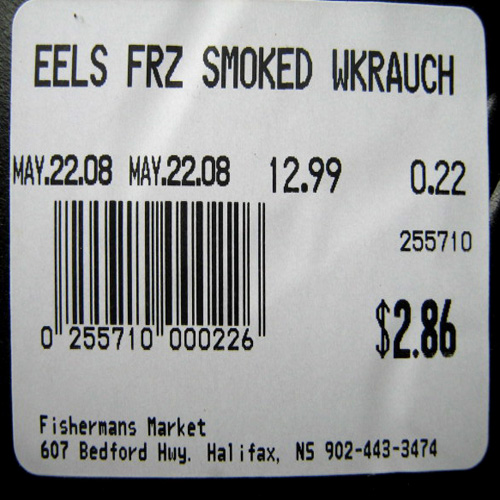
The white flesh is delicious - sweet, moist and buttery on the tongue. This sample was smoked in Tangier, NS by Willy Krauch and Sons Ltd. and to be honest I've yet to try anyone else's product so I can't compare. I can say I was expecting a mouthful of salty smoke but that's not at all what I got. Apparently it's also common to eat the smoked skin but I would say it's a distant second compared to the meat.
The First Nations people have been eating the American eel for thousands of years, as evidenced by the petroglyphs at Kejimkujik National Park in south central Nova Scotia. They saw kat as more than just a food source to be stewed, baked or smoked, it was a medicine and its skin (kadaagel) was used for binding clothes and tools.
I've never seen eel on a restaurant menu or available fresh at the market, only smoked. I've seen guys out on the river catching them, maybe that's the next step for me!
-
I’ve spent over a decade in Nova Scotia, first as a student in the early nineties and now as a fulltime resident with a family, house, career, etc. I didn’t grow up here which, I believe, is why I find the traditional home style cooking so interesting. In the year that’s passed since I did my eG Foodblog: Nova Scotia Eats (click) I have continued to collect and sample traditional recipes wherever I can find them. I think a dedicated topic thread would be a good way to share my findings and to solicit on-topic material from other Society members.
There are almost one million people living in Nova Scotia and 93% are English speaking, followed by French, Arabic, Mi'kmaq and German, according to the 2006 census. The first people got here over 10,000 years ago and are believed to be the direct ancestors of the Mi’kmaq, also know as Micmac. The Vikings may have been here a thousand years ago but unlike Newfoundland – a four hour ferry ride north – there’s no evidence of a permanent settlement and certainly no food-related legacy.
Although John Cabot visited Cape Breton in 1497, the French were the first Europeans to set up a permanent colony in Nova Scotia. At the turn of the 17th century, Champlain founded Port Royal and what was to become Acadia – a culture whose food is alive and well throughout Nova Scotia and beyond. The British Empire prevailed in the 1700’s, the Seven Years’ War ended and most of New France became British territory. After the US War of Independence, white and black Loyalists arrived bringing their own food traditions.
During the 19th century, immigrants from Ireland, Germany and particularly Scotland further settled the province. Today there are communities in Cape Breton and Pictou County that still speak Scottish Gaelic and cook traditional Highland meals.
The Port of Halifax continues to receive new Canadians from all over the world, many of whom choose to stay in Nova Scotia and contribute to the culinary culture.
So if you have thoughts on Digby chicken, rappie pie, house bankin, clapshot, blueberry grunt, Lunenburg pudding, hodge podge, kat, or anything else you associate with traditional Nova Scotia food, then this is the place.



Garlic: Tips and Troubleshooting, Selecting, Storing, Recipes, Safety
in Cooking
Posted
I once had a 1 kg sack of garlic bulbs - I peeled the cloves and froze them on a cooking sheet like people do for berries. Into a resealable freezer bag they went for frozen garlic on demand. It worked out well enough but the garlic was a little mushy after defrosting.